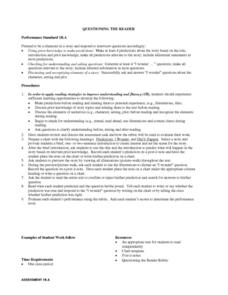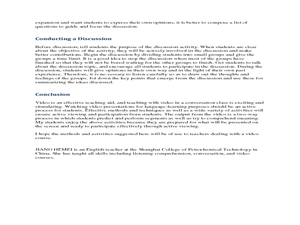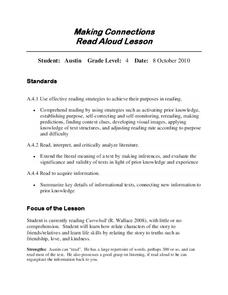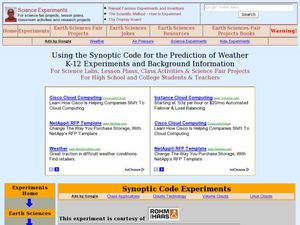Curated OER
Questioning the Reader
Students consider various reading strategies to improve their understanding and fluency. They review their assessment task and rubric for how their work will be evaluated. They read a story and predict what will happen by recording...
Curated OER
Jellybean Graphs
Second graders predict and graph data based on the color of jelly beans they think are in a handful. In this prediction lesson plan, 2nd graders will predict how many of each color jellybean are in a handful. Then they graph these...
Curated OER
The Secret School
Fourth graders make predictions and go over vocabulary for the story The Secret School. In this reading lesson plan, 4th graders use comprehension skills as they read the story and have to read to them.
Curated OER
The Tell - Tale Heart
Students read The Tell Tale Heart and practice critical analysis while reflecting on its underlying meanings. In this reading lesson plan, students make predictions, monitor their own comprehension and adjust their reading accordingly....
Curated OER
What's Your Opinion
Students complete a questionnaire, formulating opinions on issues that be addressed in the novel, Sing Down the Moon. They make predictions about events that might occur in the novel based on the group discussion.
Curated OER
Things Aren't Always What They Seem
Students use video and the Internet to make predictions, draw conclusions, determine conflict and point of view while reading a short story. In this short story analysis lesson plan, students watch a related video and complete a...
Curated OER
Running the Road to ABC
Second graders, while reading and discussing the book, "The Best Older Sister," by Sook Nyul Choi, practices predicting the meaning of a passage based on its title and illustrations. They experience determining the main idea from text...
Curated OER
Phoebe The Spy
Fourth graders read the book, Phoebe The Spy, by Judith Berry Griffin. They complete comprehension activities, make predictions about what happen next, and create a PowerPoint book report for the story.
Curated OER
Pinky and Rex and the Just Right Pet
Students engage in reading comprehension activities for the story "Pinky and Rex and the Just Right Pet". In this reading comprehension lesson, students make prediction drawings before reading the story, create new illustrations for...
Curated OER
Set the Scene
Third graders read the story "A Bargain for Frances" and make predictions about the unfolding plot of the story. In this set the scene instructional activity, 3rd graders examine the three parts of a story; the beginning, middle, and end.
Curated OER
Sink or Float
First graders explore items that sink or float. They cut and glue pictures of objects that they predict will sink or float. Students place thir pictures on a picture of a bucket of water. Students then color the objects that they had...
Curated OER
Do You Feel Lucky?
Students calculate simple probabilities using mathematics then roll dice to test their predictions.
Curated OER
The Frog and the Ol' Black Fly
Students explore frogs. In this cross curriculum literacy and frogs lesson, students predict the plot and then listen to the book The Wide-Mouthed Frog by Keith Faulkner. Students define "predator" and identify foods a frog might eat. ...
Curated OER
A River Runs Through It; Anticipation Guide
Students answer questions to consider before they read A River Runs Through It. In this anticipation guide lesson, students complete a worksheet responding to declarative statements and then discuss their responses in groups in which...
Curated OER
Stump the Dump Maze Game
Students complete reading Because of Winn-Dixie individually or as a class. As students reunite Opal and Winn-Dixie in this timed reading comprehension maze game, they demonstrate their understanding of the novel's plot, theme, and...
Curated OER
Teaching with Video in an English Class
Students participate in a video English class. In this video lesson, students read a play then video activities they do to better understand the play. Students video themselves answering questions about the play then listen to the...
Curated OER
Guided Reading Organizer for Chain Reaction
The class uses Chain Reaction, a magazine, to build a better understanding of Latin and Greek roots found in scientific vocabulary. They use two attached worksheets to help them read a scientific article, using visual clues and their...
Curated OER
Introduction to E-Discussion
Here's an interesting way to incorporate technology into your classroom. Have your young readers conduct an e-discussion of a story they are currently reading. Learners can post and/or respond to the comments of others reading the same...
Curated OER
Making Connections
Fourth graders investigate visual imagery to aid reading comprehension. In this reading strategies lesson, 4th graders discover how visual imagery helps in comprehending a story. Students use a reader's notebook to record connections.
Curated OER
Aaron's Hair
Students listen to the story Aaron's Hair. They make predictions while listening to the story. They select where the /h/ sound is heard in the pictures that represent the word.
Curated OER
Then What Happened?
Students complete activities about the story "Diary of a Worm", by Doreen Cronin. In this reading comprehension lesson, students make predictions and apply prior knowledge about the topic of the story. They actively listen as the book is...
Curated OER
Tangerine: Anticipation Guide
Encourage your readers to make predictions about Edward Bloor's young adult novel, Tangerine, with an anticipation guide that presents statements that introduce key issues in the novel.
Museum of Disability
Stand in My Shoes
Stand in My Shoes, a story by Bob Sornson, is an effective way to teach young learners about empathy and making friends. Once pupils read through the story, they answer a series of discussion questions and complete reading activities...
Curated OER
Using the Synoptic Code for the Prediction of Water
Students construct a thermoscreen for the experiment. In this earth science instructional activity, students make observations and interpret them using synoptic codes. They predict the weather based on gathered information.

























